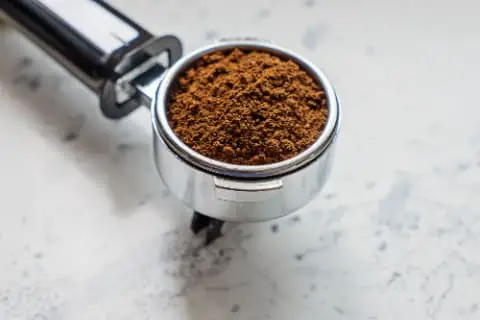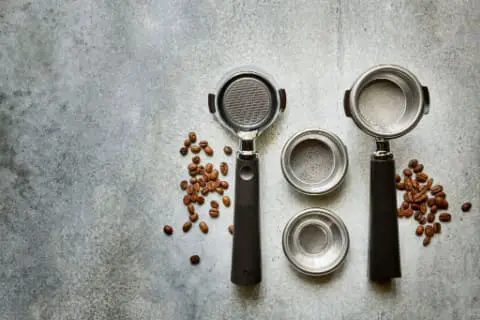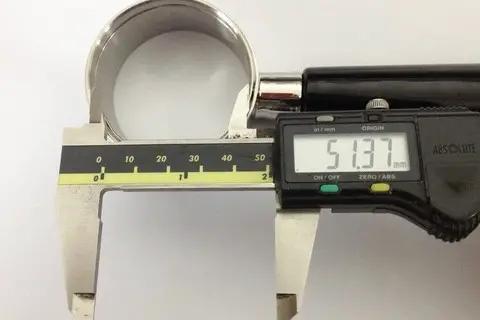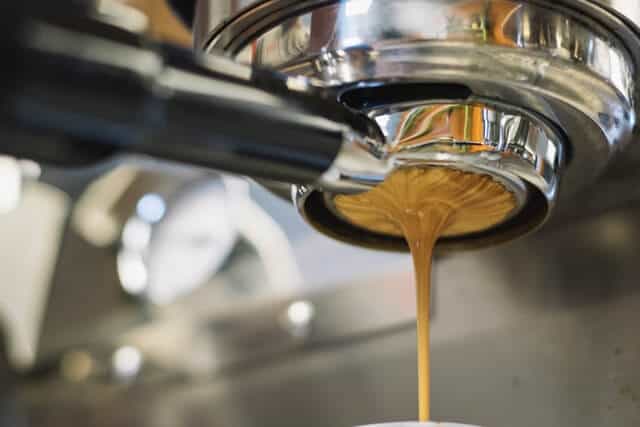As an Amazon Associate I earn from qualifying purchases. When you use our links, we may earn an affiliate commission. Learn more.
When making coffee, you must decide between a pressurized or non-pressurized portafilter. Both can produce great-tasting espresso; however, there are some critical differences between the design and use cases of both options, which I will explain in this article.
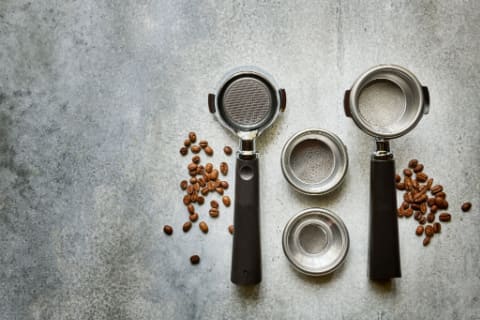
So, what is a pressurized vs. non-pressurized portafilter?
The main difference between a pressurized and a non-pressurized portafilter is the number of holes in the basket and how they create the required pressure to extract the optimal espresso flavor. A pressurized portafilter has only one hole in the basket and relies on the basket to create extraction pressure.
In contrast, a non-pressurized portafilter has multiple holes and depends on a finely ground and tamped puck to generate extraction pressure.
This means that a non-pressurized basket is more forgiving and best suited to beginner home baristas. In contrast, a pressurized basket can give a better flavor but requires accurate coffee grinding and tamping to achieve the best-tasting espresso.
Here’s my side-by-side comparison of both portafilters so you can understand their differences:
5 Differences Between Pressurized and Non-Pressurized Portafilters
So, what are the key distinctions between the portafilter basket types, and when should you use each?
| Pressurized Portafilters | Non-Pressurized Portafilters | |
| Best For | Best for beginners | Suited to more advanced users |
| Basket Type | Two chambers, with a single small hole at the bottom | Single chamber, multiple holes in the base |
| Taste Profile | Can deliver a reasonable taste profile with minimal expertise | It can provide a better taste profile and requires a higher barista experience. |
| Importance of Grind Size | Low importance because the basket generates extraction pressure | High importance because the puck causes extraction pressure |
| Degree of Control | Minimal level of control | A higher degree of control |
| Price | Cheaper | More expensive |
Finding the right coffee maker for you can take time and effort.
The best place to start is considering whether you want a pressurized or non-portafilter. Read on to understand the critical differences between these coffee brewing approaches.
Quality Of the Espresso
Let’s start with the most crucial aspect to consider, the quality of the espresso. Both of these machines are capable of making delicious beverages.
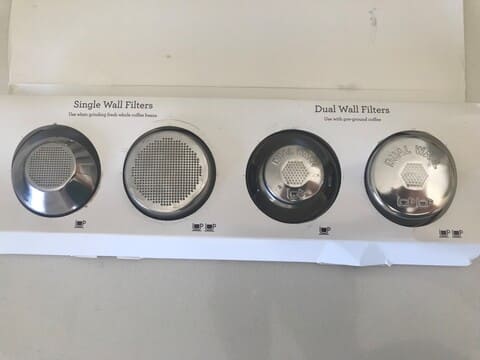
Which one will deliver the best results, though, will often depend on what you are at in your barista journey.
If you are just getting started, you should use a use a pressurized portafilter. This is designed for beginners. As we’ll discuss, elements like grind size and tamp pressure aren’t overly critical. This ensures that anyone can get a delicious espresso.
On the other hand, if you have more experience making coffee, consider a non-pressurized portafilter.
This gives you more flexibility, allowing you to create the beverage exactly how you like it. When done correctly, the coffee made with a non-pressurized portafilter will be superior to the one produced by a pressurized option.
This is why professional baristas will use non-pressurized portafilters in their coffee shops.
Construction of the Portafilter
The easiest way to spot the differences between the two baskets is by looking at how each portafilter is built. Pressurized portafilters will have two compartments.
First is the basket where you will place your grounds. Similar to the non-pressurized basket, this will have a series of small holes in the base.
The second compartment has a small hole in the bottom.
This causes the pressure to build up, allowing the beans to extract flavor. When the right amount of pressure is reached, the coffee will start flowing from the portafilter into your cup.
On the other hand, non-pressurized portafilters have a series of small holes in the base of the basket.
It doesn’t have a second chamber as the pressurized basket does.
This is because the coffee machine and puck are responsible for regulating the amount of pressure provided. When the correct pressure is reached, the water will flow from the bottom of the basket into the cup.
Some people opt to upgrade their non-pressurized portafilters to the precision basket.
This means that each of the holes in the bottom is evenly sized and evenly spaced. As a result, the water won’t get clogged in the portafilter. This will allow you to create a smoother pour.
Another type of basket is known as a bottomless portafilter.
This is just a basket without any holes in the bottom. This will allow you to see the flow of the shot as it is poured. This lets to improve your preparation method, making it obvious if you have tamped one side unevenly.
This is only available for non-pressurized portafilters.
Importance Of Grind Size
The next thing to consider is how important it is to get the right grind size. In both of these machines, it’s important to play around a little to get a good grind. This ensures that you can get the best possible flavor from the beans.
But this process is least important when you are using the pressurized option.
The coffee won’t release until the proper pressure is built. Remember that you don’t need to tamp excessively, making it too hard for the water to pass through the grounds.
This is why pressurized baskets are often recommended to beginners.
Furthermore, if you like to purchase pre-ground coffee, you will be better off with a pressurized portafilter. You shouldn’t have any problems turning it into a delicious drink if you use a fine grind size.
You are more likely to taste the difference in grind size when using a non-pressurized portafilter. It can take a while to achieve the grind size that you prefer.
Here are two things to bear in mind:
- Bitter or acidic taste. This means that the coffee has been over-extracted. This is a sign that the grind is too fine. This can also signify that you are using cheaper regular coffee than high-quality espresso beans.
- Coffee is too weak. This means that you aren’t extracting enough flavor from the beans, so you will need to grind them a little finer.
Amount Of Control Over The Brewing Process
The next thing to consider is the amount of control you want to exert over the brewing process. If you want complete control over your coffee tastes, consider using a non-pressurized machine.
You can adjust the amount of pressure you are using to extract the beans.
Usually, between seven and nine bars is the sweet spot. This will allow you to produce the crema foam on top of the espresso. Increasing the pressure will extract the coffee from the grounds faster.
The pressure isn’t the only element that you can customize. Some of the other aspects include the following:
- Water temperature
- Tamp pressure
- Size of the grind
- Type of beans
A relatively minor change in any of these elements can dramatically affect how your espresso tastes.
If you like to experiment with these factors, start a coffee diary. This will allow you to take notes of your changes and how they impacted the blend.
On the other hand, pressurized portafilters are known for their ease of use.
Fill it with coffee, put it into the machine, and pull the shot. All the hard work will be taken care of. You won’t need to worry about the consistency of your ground beans.
Price
Consider considering the price associated with purchasing the portafilter. Non-pressurized portafilters will require more technical elements.
For example, the group head must be able to regulate the pressure. As a result, they will often be more expensive to purchase than pressurized models.
Furthermore, if you want to use a non-pressurized basket, you will need to buy a grinder. This can be expensive, with a high-quality electric model costing at least $100.
It should be noted that some machines – such as the Breville Barista Express, which I use – allow you to use both baskets, depending on your experience level.
This can save you money, as you don’t need to upgrade to a new machine when you want more control over the process.
This free cheat sheet will improve your coffee brew by providing quick information on brew ratio, grind size, optimal brewing time, and more.
FAQ’s
Should I Use A Pressurized Portafilter?

You should use a pressurized portafilter if you are a beginner barista, have a grinder capable of producing fine ground coffee or own a coffee machine that cannot make the seven to nine bars required for great-tasting espresso.
Why Is A Non-Pressurized Portafilter Better?
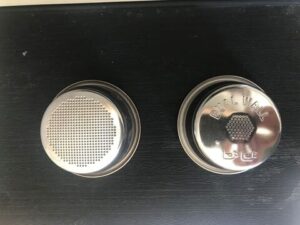
Non-pressurized portafilters are better for experienced baristas because they deliver better espresso with a richer crema and fuller-bodied flavor. Achieving this requires a finer grind and firmly tamped puck, which takes more experience to master.
As such, a non-pressurized portafilter may not be better for an inexperienced barista or someone who doesn’t have a decent grinder and espresso machine.
What Is Pressurized vs. Non-Pressurized Espresso: Verdict
Finding the right portafilter for you doesn’t have to be complicated. Generally, a pressurized portafilter is best if you are a beginner or looking for a simple approach. For more advanced users, or those seeking more control over the brewing process, a non-pressurized portafilter is a good choice.
This free cheat sheet will improve your coffee brew by providing quick information on brew ratio, grind size, optimal brewing time, and more.
